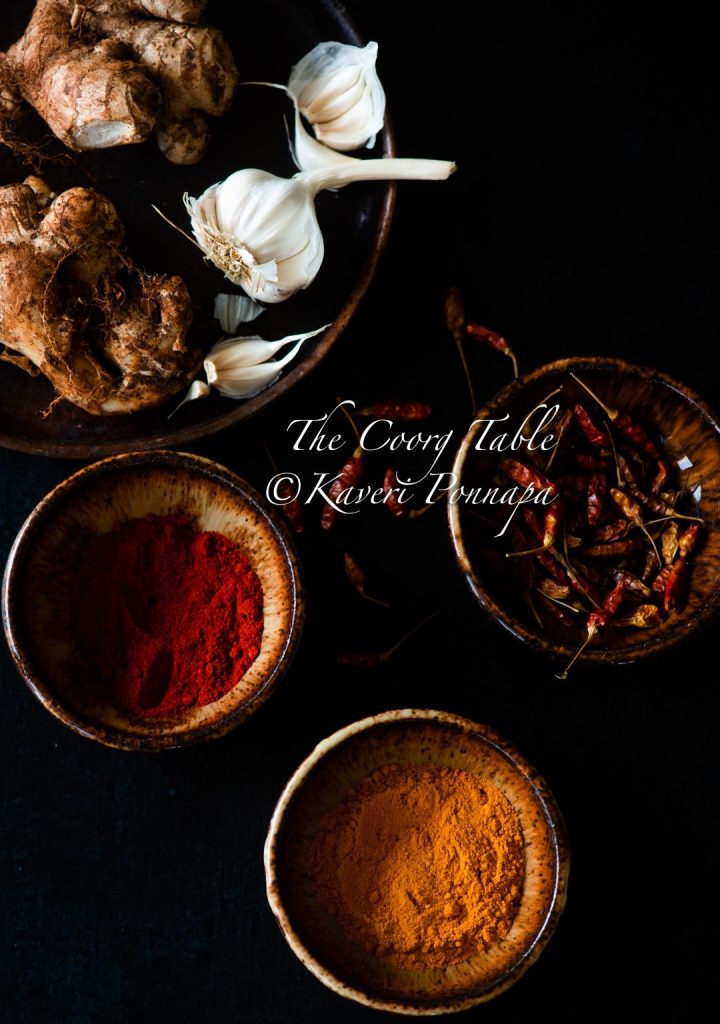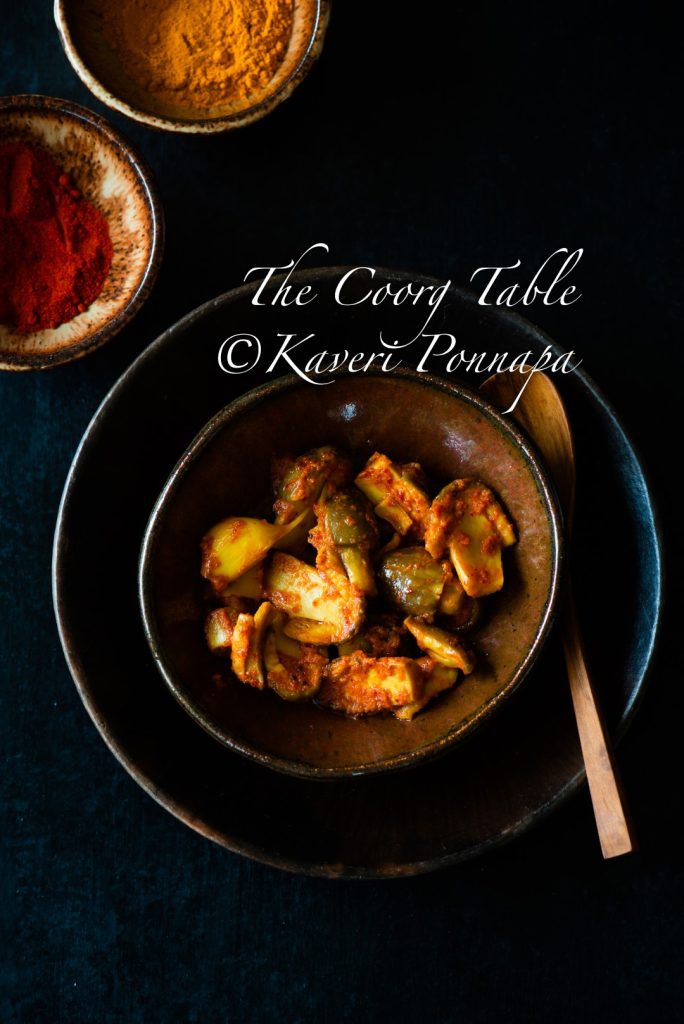Last year, ālë kummë, fragrant and substantial, poured in: tight buds, open caps, tall, short, every shape and size possible. I am obsessed with wild mushrooms, and the sight of bag after bag landing on my kitchen table put me in a haze of happiness. I cleaned, sliced, cooked, roasted, and still they poured in. The tightest, freshest buds went into two large jars of pickle, probably the best I have made in decades. The sheer volume of fresh, wild mushrooms had me thinking about our old belief, that these fungi proliferate after thunderstorms, springing up after rain and lightning, in the same places, year after year. While mushroom hunting after the rains on coffee plantations, we returned to familiar spots, and were never let down. The science behind this magic lay below the soil, where the spores by which mushrooms reproduce grew into hyphae, long filaments, a mass of which created a mycelium, which, under ideal conditions, produced the mushrooms we harvested year after year.
Some fascinating, contemporary scientific research from Japan, another mushroom loving food culture supports this old belief. As part of a four year-long study at Iwate University led Koichi Takaki, associate professor, demonstrated that jolts of electricity simulating lightning strikes significantly increased volumes of mushrooms produced by certain cultivated species.

When lightning strikes in Nature, it was assumed that a charge ran through the soil, stimulating mushrooms to reproduce more abundantly, prompted by changes in temperature and other factors, including a need to reproduce in the face of a threat to their existence—lightning strikes. The experiments— extensive and varied—all led back to the familiar belief that lightning increases the numbers, and sometimes, the size and density of mushrooms. After browsing through several articles online, including this one : https://www.nationalgeographic.com/science/article/100409-lightning-mushrooms-japan-harvest I wondered if last year’s generous haul was the result of multiple lightning strikes across the edges of forest from where it had been harvested by tribal people.
The pickle itself, which is all that is left of that harvest, is meaty treat, the dense textures of the ālë kummë ideally suited for the acid, spice and oil that help preserve it. Coated in a little spice and plenty of oil, the texture lasts remarkably well under refrigeration, and we have had almost a year of savouring these beautiful mushrooms.


After much reading, I am not sure how I feel about the use of simulated lightning to increase harvests of cultivated mushrooms. As for wild mushrooms, the idea of leaving them to lead their secret lives in forests, fields, on fallen logs, the greater part of their lives underground, invisible to us appeals more than increased harvests. In Coorg, the demand for wild mushrooms grows as the tourist traffic increases, even as climate change and aggressive farming practices deplete supplies. The land can only supply what it is allowed to produce. Everyone wants a taste of local, wild foods: Chefs on the lookout for novel, attention-grabbing dishes for their ‘pop-up’ menus often ask about how they should go about sourcing wild mushrooms. An answer they might not understand runs through my mind, taken from a modern Kodava poem, which, in two, short lines, evokes an entire season, the sense of eager anticipation, and a far gentler way of taking only what you need from the land:
“At the first rumble of thunder
women set out in search of Ëdënji kummë”.
When did you last see a harvest of all the mushrooms your grandparents remember?
This post first appeared on The Coorg Table ® by Kaveri Ponnapa. Kaveri is a prolific writer and acknowledged authority on Coorg Cuisine known for the thorough research and background work she undertakes for all her writings.
To read more posts by Kaveri, visit her blog at https://kaveriponnapa.com



The rain and rainy time cuisines remind me of my childhood days. Such a lovely article!!!
Lovely piece. I learned so much about the lifecycle of mushrooms. The fact that lightning strikes stimulates the growth of mushrooms was a revelation. Sadly, mushrooms, especially the exotic ones, have become a huge draw, leading to a shortage, which in turn drives up the prices. This results in a destructive cycle.
Kaveri,
You really went down the rabbit hole on this one ! We’re lucky we can still get some wild shrooms at the local Farmer’s market. Way better than the farmed ones.
Very well articulated. Natural Mushrooms act as a superfood as they are high in nutrients and have many health benefits. I could eat Mushrooms everyday if I wish ,although only as part of a balanced diet with other foods.
Kodava’s hold a very sacred place for mushrooms in their heart.
Not many people, but the Kodava’s would have seen, eaten or heard of the variety of mushrooms like we in Kodagu.
Very well articulated artical and intricate research. Hope to see many more covery a whole lot more ingredients from Kodagu.
Your articles are also unique like Edenji Kumme!
These well researched articles are my final point of reference for anything about Coorg ! Yes, since we have started understanding the need for sustainability in foraging, cultivating or consumption, this article is in the right direction for all the stakeholders !
Kaveri writes so seamlessly on every subject she takes up.
The research and work at the back end is her labour of love and her passion for nature , environment, food , Coorg and more . Her writings get you to think and question.
This article is so well penned and evocative, stirring up my memories of truffle hunting near Turin, Italy. I believe there are many aromatic mushrooms out there waiting to be discovered and celebrated as luxury produce. Such a discovery could indeed benefit the rural economy.
Mushrooms are one of my favourites and especially the ones we get in Coorg during this season. Unlike other mushrooms, these wild mushrooms offer a very unique taste and texture to the dish. Every year we get quite a bit of it and my mother would cook and freeze them, only to be enjoyed later. Being prudent to ensure that they survive for years to come is our responsibility. If we lose them, we can only blame ourselves.
We still go hunting for mushrooms after thunderstorms 😊
“the land will only supply what it is allowed to produce ” has so much meaning and sets you thinking what we have done to the ever reducing forest that provided us so much. Were we mights just be left with photos to prove to the world that they sometimes existed in the past.
I have been following Kaveri’s writings for over a decade – she takes painstaking efforts to go into as much details as possible and yet writes her content in the most comprehensible and beautiful prose.
We love mushrooms and this delicacy is becoming more and more rare as the days go by due to use of pesticides and chemical fertilizers. Nature provides us enormous variety of edible products; if only we could respect the land that provides us these precious foods we could be eating more healthily and safely.